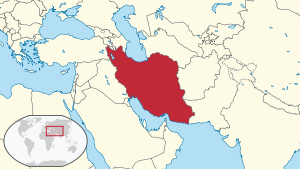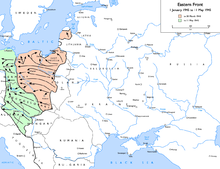Soviet involvement in regime change
In the 1920s, the nascent Soviet Union intervened in multiple governments primarily in Asia, acquiring the territory of Tuva and making Mongolia into a satellite state.
[1] During World War II, the Soviet Union helped overthrow many puppet regimes of Nazi Germany and the Empire of Japan, including in East Asia and much of Europe.
However, when Bogd Khan died in 1924, the Mongolian Revolutionary government declared that no reincarnations shall be accepted and set up the People's Republic of Mongolia which would exist in power until 1992.
[24] In 1934, Ma Zhongying's troops, supported by the Kuomintang government of the Republic of China, were on the verge of defeating the Soviet client Sheng Shicai during the Battle of Ürümqi in the Kumul Rebellion.
As a Hui (Chinese Muslim), he had earlier attended the Whampoa Military Academy in Nanjing in 1929, when it was run by Chiang Kai-shek, who was also the head of the Kuomintang and leader of China.
In 1934, two brigades of about 7,000 Soviet GPU troops, backed by tanks, airplanes and artillery with mustard gas, crossed the border to assist Sheng Shicai in gaining control of Xinjiang.
Chinese Muslim troops led by Ma Shih-ming held off the superior Red Army forces armed with machine guns, tanks, and planes for about 30 days.
Catalan Trotskyist Andreu Nin, socialist journalist Mark Rein, left-wing academic José Robles, and others were assassinated in operations in Spain led by many spies and Stalinists such as Vittorio Vidali ("Comandante Contreras"), Iosif Grigulevich, Mikhail Koltsov and, most prominently, Aleksandr Mikhailovich Orlov, who later defected to the United States.
Many sources conclude that the Soviet Union had intended to conquer all of Finland, and use the establishment of the puppet Communist Finnish Democratic Republic and the Molotov–Ribbentrop Pact's secret protocols as evidence of this.
The dismantled installations were repatriated to Russia and the site returned to Latvian control, with the last Russian soldier leaving Baltic soil in October 1999.
Its purpose was to secure Iranian oil fields and ensure Allied supply lines (see the Persian Corridor) for the USSR, fighting against Axis forces on the Eastern Front.
[72] As World War II turned against the Axis and the Soviet Union won on the Eastern Front, several Romanian politicians, including Mihai Antonescu and Iuliu Maniu, entered secret negotiations with the Allies.
[citation needed] After the Soviets launched a successful offensive into Romania King Michael I met with the National Democratic Bloc to try and take over the government.
The Soviet representatives pressured the king into appointing Petru Groza, the candidate put forwards by the communist alliance, as the Prime Minister of Romania in March 1945.
Subsequent military operations lasted for the following 20 days and ended on 6 October 1939 with the two-way division and annexation of the entire territory of the Second Polish Republic by Germany and the Soviet Union.
Around 13.5 million Polish citizens who fell under the military occupation were made into new Soviet subjects following show elections conducted by the NKVD secret police in the atmosphere of terror,[88][89] the results of which were used to legitimize the use of force.
A Soviet campaign of political murders and other forms of repression, targeting Polish figures of authority such as military officers, police and priests, began with a wave of arrests and summary executions.
[95] After the end of World War II in Europe, the USSR signed a new border agreement with the Soviet-backed and installed Polish communist puppet state on 16 August 1945.
This agreement recognized the status quo as the new official border between the two countries with the exception of the region around Białystok and a minor part of Galicia east of the San river around Przemyśl, which were later returned to Poland.
Their rule saw the Stalinization of the country, and with the help of the USSR sent dissidents to Gulags in the Soviet Union, as well as setting up the Security Police known as the State Protection Authority (AVO).
During the full course of the Vistula–Oder operation (23 days), the Red Army forces sustained 194,191 total casualties (killed, wounded and missing) and lost 1,267 tanks and assault guns.
The fall of Königsberg allowed Stavka to free up General Konstantin Rokossovsky's 2nd Belorussian Front (2BF) to move west to the east bank of the Oder.
[103] The three Soviet fronts had altogether around 2.5 million men (including 78,556 soldiers of the 1st Polish Army): 6,250 tanks, 7,500 aircraft, 41,600 artillery pieces and mortars, 3,255 truck-mounted Katyusha rocket launchers, (nicknamed "Stalin Organs"), and 95,383 motor vehicles, many of which were manufactured in the USA.
[122] The Czechoslovak Army, under the direction of Defence Minister Ludvík Svoboda, who was formally non-partisan but had facilitated communist infiltration into the officer corps, was confined to barracks and did not interfere.
[48] The new government that came to power during the revolution formally disbanded the Hungarian State Protection Authority, declared its intention to withdraw from the Warsaw Pact and pledged to re-establish free elections.
Within South Vietnam, rumors persisted for years that men with blue eyes were reportedly spotted doing recon missions and testing their new SVD Dragunov sniper rifles.
[132] In 1960, Belgium, the United States, and other countries covertly overthrew Prime Minister Patrice Lumumba in a coup led by Mobutu Sese Seko.
ZIPRA (Zimbabwe People's Revolutionary Army), the armed wing of ZAPU, took advice from its Soviet instructors in formulating its vision and strategy of popular revolution.
[165] On the night of 20–21 August 1968, Eastern Bloc armies from four Warsaw Pact countries – the Soviet Union, Bulgaria, Poland and Hungary – invaded Czechoslovakia.
To implement the new reforms in the country, Vietnam, with support from the Soviet Union, started transferring several years' worth of military equipment to the Kampuchea People's Revolutionary Armed Forces, which numbered more than 70,000 soldiers.


















